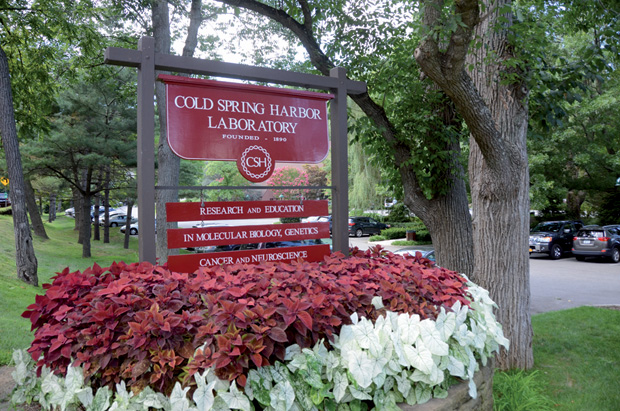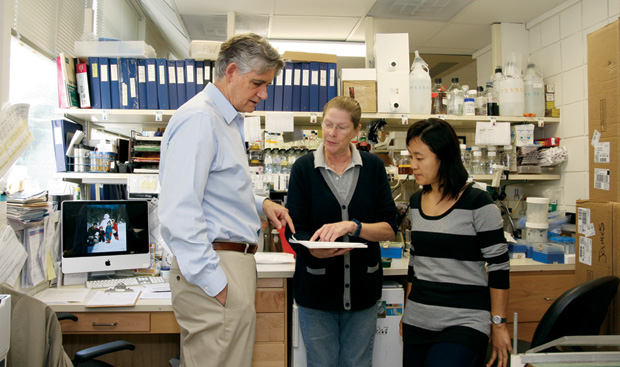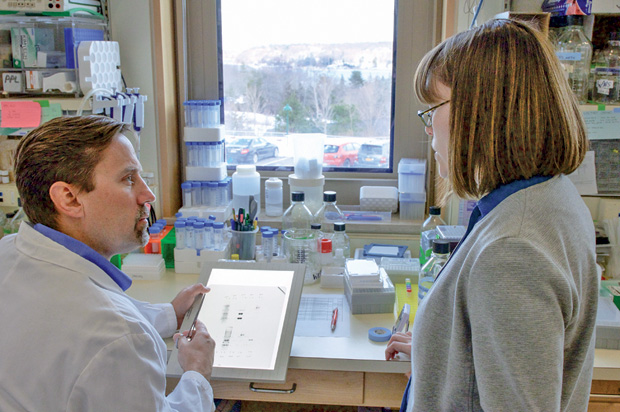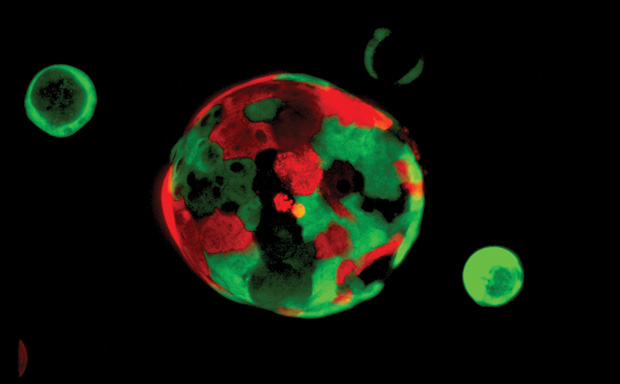Located on the north shore of Long Island in New York, Cold Spring Harbor Laboratory (Figure 1) started out with a marine biology emphasis at the end of the 19th century, but it soon established itself as a prominent cancer research facility. That strong emphasis on cancer work continues today as this private, not-for-profit research institution enters its 127th year (Figure 2).
As part of its drive to understand all aspects of cancer and apply that knowledge to diagnostics and treatments, the laboratory is planning an overhaul of one of its historical buildings to focus on the relationship between obesity, metabolism, and cancer. Cold Spring Harbor has also entered into a clinical collaboration with a major healthcare system to establish a preclinical experimental therapeutics pipeline to accelerate new cancer diagnostics and therapeutics approaches.


IEEE Pulse sought out Bruce Stillman (Figure 3), Cold Spring Harbor’s president, chief executive officer, and director of its Cancer Center, as well as David Tuveson (Figure 4), M.D., the deputy director of the Cancer Center, to get their views on overall progress in the War on Cancer, as well as the institution’s own multifaceted role in the fight against this still-devastating disease.
IEEE Pulse: Looking back over the past 45 years since the War on Cancer began with the signing of the National Cancer Act of 1971, how far have medicine and science come?
Bruce Stillman: In the late 1960s and early 1970s, it was an interesting time because it was only a few years earlier that the genetic code had been cracked. So, while we knew a bit about the genetics of cancer, we had very little understanding of the cause of cancer. Since then, we have seen a dramatic increase in the technology related to the life sciences, including recombinant DNA in the mid-1970s, the ability to sequence DNA in the 1970s and 1980s, and eventually the ability to sequence whole genomes, including the entire genome of a person. We’ve also seen the development of monoclonal antibodies, which are a very big part of therapeutics these days, and increasingly smart ways to employ them.
Plus, there is now the understanding of the genetics of cancer in great detail, of tissue homeostasis and how the control of cell proliferation and cell death have to be balanced, of how the immune system is surveilling abnormal growths, and of how inappropriate tissue growth in one place can move to another site in the body through metastasis. I would say that the enormous growth in understanding how our biology works, how cells work, and how tissues work has impacted our insight into not just cancer but also a lot of other diseases.


IEEE Pulse: Now that we have this foundation of knowledge, what comes next in the War on Cancer?
David Tuveson: I look at the efforts over the last 45 years as defining two different phases in our approach to cancer. The majority of the time over the last 45 years has been spent on defining cancer as being made up of broken genes and being caused by various processes that promote the breaking of genes. These processes can be things like exposure to mutagens, such as ultraviolet light and tobacco smoke, as well as inflammation, which can be stimulated by your diet, obesity, hormonal imbalances, the microbiome in your intestines, and, in some people, by an immune system gone haywire as can happen with autoimmune diseases. I call this all phase one.
At this moment in time, I think we’re at the end of phase one, and we’re entering phase two, which is the stage where we can now implement the knowledge from phase one into actually developing better therapies and better diagnostics.
IEEE Pulse: What is Cold Spring Harbor doing to help move into this second phase in the War on Cancer?
Stillman: One important thing is the establishment of this big clinical collaboration between Cold Spring Harbor Laboratory and Northwell Health, which is the largest healthcare system in the New York metropolitan region. Northwell has a very large number of cancer patients each year, and we integrated with them to create a preclinical experimental therapeutics pipeline, which allows us to incorporate very innovative animal models and also three-dimensional tissue cultures, called organoids, to move our basic research to the clinic.
IEEE Pulse: What are organoids, and what advantages do they provide?
Stillman: Most science over the last 45 years has been done by growing human, mouse, or rat cells in two-dimensional cultures. A few years ago, a group in The Netherlands developed the idea of growing primary human tissue in three dimensions in essentially an artificial gel [1]. These are organoids. [See Figure 5.]
Tuveson: So overall, organoids are small—the size of a period at the end of a sentence, so you need a microscope to see them—and they’re grown quite easily from normal epithelial tissue and from the cancer that originates from that epithelial tissue. They allow us to very quickly compare what’s different in a patient’s cancer cells compared to their normal cells. You can’t do that experiment in any other way that I’m aware of.
This is something that we’ve always been missing in cancer research and cancer medicine. By being able to do the comparison, you can find genetic differences, and you can potentially find drugs that hurt the cancer but not the normal cells. The breakthrough of the organoids is that it gives you a clear looking glass into the process of cancer, because you have normal tissue as a reference point.

IEEE Pulse: How did organoids become part of the research at Cold Spring Harbor?
Tuveson: Hans Clever’s group from The Netherlands was willing to collaborate with us on codeveloping organoids for pancreas cancer. We’ve had a very productive collaboration for almost five years now, and we have been able to develop the approach to work so well from a scientific standpoint that many investigators around Cold Spring Harbor campus are now applying it to other cancers they are studying, including breast and prostate cancer.
IEEE Pulse: Pancreas cancer remains an aggressive and deadly cancer, and one that is a particular focus of yours, Dr. Tuveson. What in particular are you studying?
Tuveson: We have found a new process inside cells that we feel could be a therapeutic approach to take for this disease. It involves manipulating the control of reactive oxygen, or the free radical form of oxygen, in cancer cells. We’ve found that when cancer cells, and particularly pancreas cancer cells, are exposed to reactive oxygen, they will stop growing and stop proliferating. So, using the organoid model, we’re looking at and testing a new preclinical experimental therapeutics approach to see if that can lead to a new option for treating pancreas cancer.
Beyond our work, the Blue Ribbon Panel Report was just released in September [2], and it includes the concept of employing organoids to pharmacotype cancer patients. Pharmacotyping means using pharmacological methods to identify how a person’s cancer responds best, or, in essence, personalizing their therapy independently of genotyping. This type of work can be applied more generally to other cancers beyond pancreas cancer, too.
IEEE Pulse: How will the relationship with Northwell facilitate this work?
Stillman: We have developed libraries of genetic elements associated with the expression of every single gene in the human genome, and this enables us to screen for the vulnerabilities specific to certain cancers, for instance, the vulnerabilities associated with one particular subtype of prostate cancer or one particular subtype of breast cancer. Through the Northwell Health collaboration, we have established an experimental therapeutics treatment center—and have hired a clinician to run it—to test the very earliest introduction of these therapies into people and at the same time to monitor those patients for a wide assortment of responses at the molecular level, so we will have a readout to tell us whether the potential therapy is effective.
Understanding the science at this preclinical level will allow us to have more effective late-stage clinical trials and also a better chance of having drugs approved down the road that will have a significant therapeutic effect. By significant, I don’t mean that we want to just extend life by two months. Rather, we’re looking for real long-term survival.
IEEE Pulse: How does Cold Spring Harbor’s new Center for Therapeutics Research fit into its strategy to fight the War on Cancer?
Stillman: Obesity is a big problem in this country and in other Western societies, and it is increasingly contributing to the rise in cancer, particularly among the gastrointestinal cancers, such as pancreas cancer. Diet and cancer have always been linked together, just as smoking and cancer have been linked together. We don’t fully understand it, but your genetics and physiology, as well as your microbiome, which is the types of microorganisms that exist in your gut, all can have great influences. This Center will focus on nutrition, metabolism, and cancer, and the research will include the fields of chemistry, human genetics, and whole-body metabolism. In addition, your craving for food is really driven by hormones that are released by your stomach and go to your brain, so we’ll be able to integrate these studies into the strong neuroscience program we already have here at Cold Spring Harbor Laboratory.
IEEE Pulse: Will the Center for Therapeutics Research be a completely new building?
Stillman: No, we’re actually doing a full renovation of a 1954 building that was designed by Massachusetts Institute of Technology architects. It’s a very historic building because four Nobel laureates did their research in this building, and that is pretty impressive since the building only has six laboratories in it! It was important to us to keep the building, but we’re going to fully renovate it so we can have the state-of-the-art facilities we need for the kinds of innovative metabolism, obesity, cancer, and nutrition research we will be doing.
IEEE Pulse: Now that we’re embarking on phase two, which Dr. Tuveson has described as the beginning of the end of the War on Cancer, what are the next steps in battling this disease?
Tuveson: We need much better methods for the early detection of cancer and for monitoring patients to determine whether their treatments are working. This is a challenge to the engineers, the physicists, and the other people in the physical sciences. They have been able to devise machines for other things, but so far we don’t have great ones for these uses. Today’s methods of measuring something in the blood once a week or taking a computed tomography scan once every two months are just far too slow and not at a high enough resolution to be useful. We need to know within three days whether the therapy we’re giving a patient is having a positive effect. With a much higher bar for determining response, each patient will have a far better chance of having their care personalized to fit their own cancer.
IEEE Pulse: Would better diagnostics and monitoring equipment also be helpful in designing new therapies?
Tuveson: Yes. I would say my field of cancer therapy has had mixed success in generating new drugs against cancer. While we have had some really exciting breakthroughs, a majority of our attempts have been very modest in their success in terms of therapies. A reason for that is when considering the causes of cancer—the broken genes of cancer—it’s sometimes easy to find a chemical that will inhibit a broken gene that is making a (deleterious) protein. We don’t, however, have drugs that will change a broken gene’s behavior back to normal. That’s part of the beginning of the end: better chemistry and better therapies aimed at the root causes of cancer.
What we’re trying to do here at Cold Spring Harbor is take the challenge to create better drugs and better diagnostics, and develop the methods that allow us to succeed at that. Through the use of organoids and pharmacotyping, I believe we will accelerate the drug discovery and development process, and I’m very hopeful that, five years from now, we should start to see some new therapeutic approaches and some new diagnostic approaches so people will have a much better chance of saying they used to have cancer.
References
- T. Sato, R. G. Vries, H. J. Snippert, M. Van De Wetering, N. Barker, D. E. Stange, J. H. Van Es, A. Abo, P. Kujala, P. J. Peters, and H. Clevers, “Single Lgr5 stem cells build crypt-villus structures in vitro without a mesenchymal niche,” Nature, vol. 459, no. 7244, pp. 262–265, May 2009.
- National Cancer Advisory Board. (2016, Sept. 7). Cancer Moonshot: Blue Ribbon panel report 2016 (draft). [Online].



